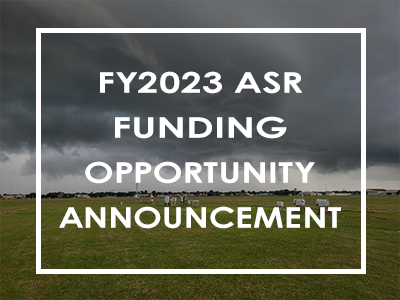DOE announces $15 million to fund ASR science
 The U.S. Department of Energy (DOE) has announced plans to provide $15 million in new research grants for Atmospheric System Research (ASR) program science.
The U.S. Department of Energy (DOE) has announced plans to provide $15 million in new research grants for Atmospheric System Research (ASR) program science.
Successful applicants will focus their research on observational, data analysis, and/or modeling studies that use observations supported by DOE’s Biological and Environmental Research (BER) program, including the Atmospheric Radiation Measurement (ARM) user facility, to address one of the following research topics:
- Cloud, aerosol, precipitation, and thermodynamic processes from ARM’s TRacking Aerosol Convection interactions ExpeRiment (TRACER).
- Cloud, aerosol, precipitation, and radiation processes from ARM’s Surface Atmosphere Integrated Field Laboratory (SAIL).
- Warm boundary-layer atmospheric processes.
- Southeastern U.S. atmospheric processes through the early use of observations from the third ARM Mobile Facility (AMF3).
“This is an opportunity to address some of the key science questions facing climate scientists today,” says ASR Program Manager Jeff Stehr. “ASR funding ensures that we continue to develop a strong understanding of atmospheric processes in the Earth system and the critical role they play as we face the challenges of a changing climate.”
Funding will be awarded competitively based on peer review and is expected to have total award amounts ranging from $200,000 to $945,000, beginning in fiscal year 2023.
More details about the research topics, award amounts, length of research projects, eligibility, and the new Promoting Inclusive and Equitable Research (PIER) Plan requirement are delineated in the funding opportunity announcement document (PDF).
Pre-applications are required and should contain a concise description of the objectives and the technical approach that makes clear how the proposed research addresses the research topics of the FOA and how ARM-supported observations are integral to the proposed research.
Full details and application instructions are available in the funding opportunity announcement DE-FOA-0002850 (PDF). Pre-applications must be submitted by 5 p.m. Eastern time Thursday, December 8, 2022. Pre-application submitters will receive a response from DOE by January 5, 2023, and formal applications will be due February 23, 2023.
# # #This work was supported by the U.S. Department of Energy’s Office of Science, through the Biological and Environmental Research program as part of the Atmospheric System Research program.

